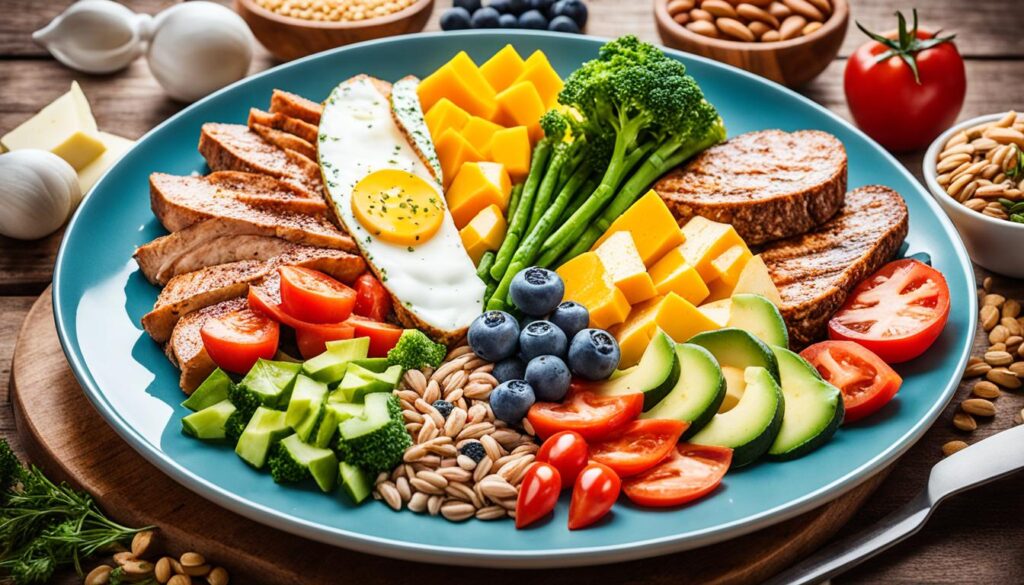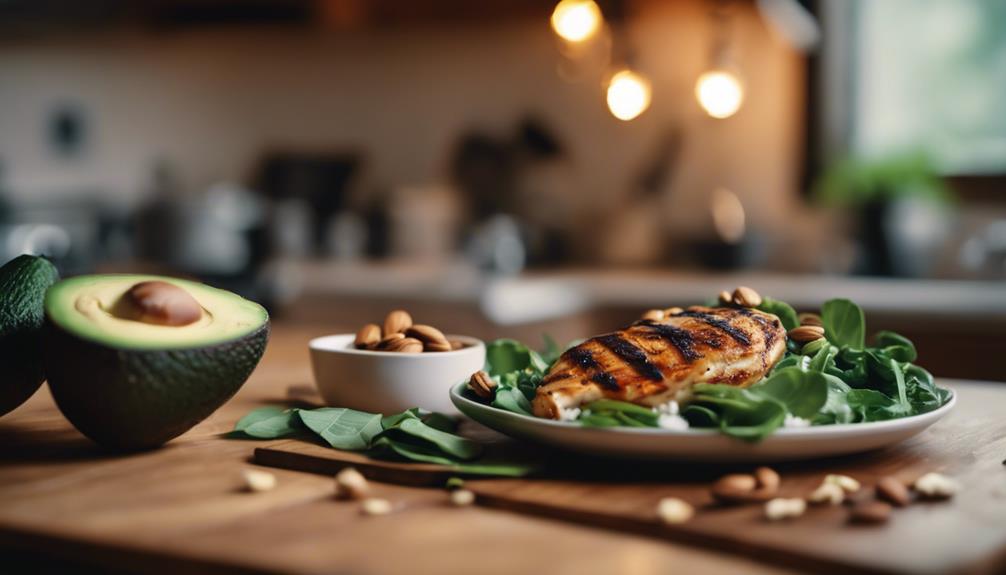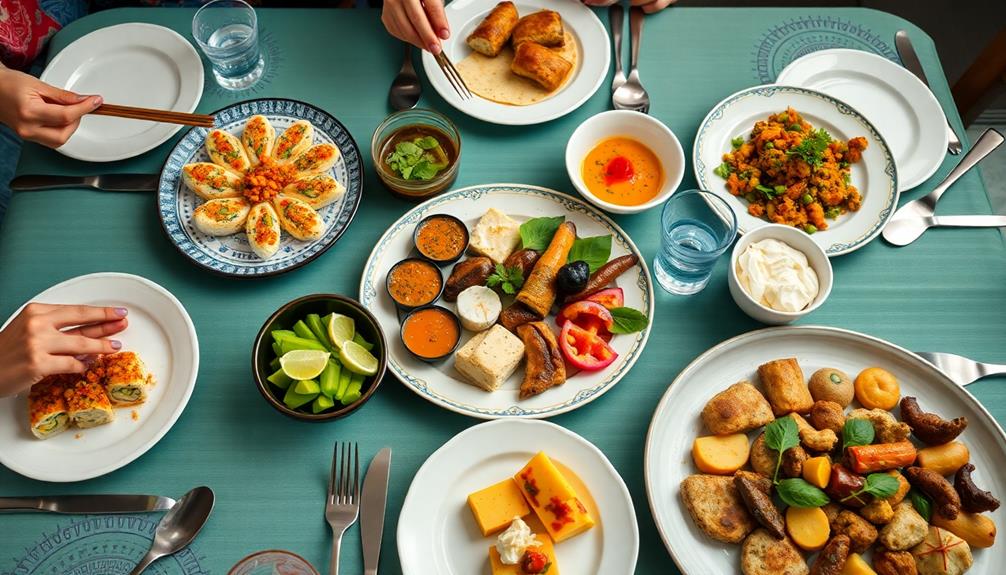Changing your diet can be challenging. Picture yourself wandering through the grocery store, surrounded by countless options, wondering, “Where should I even begin?” The ketogenic diet emphasizes consuming low-carb, high-fat foods. This not only helps with weight loss but also boosts energy levels and enhances mental clarity. Adopting this diet doesn’t just alter your eating habits; it transforms your overall lifestyle. For those embarking on this journey towards better health, having a straightforward ketogenic diet food list designed for beginners is crucial. Dive in and discover the ins and outs of this transformative way of eating.
Before you shop, it’s essential to learn the basics. Moving from a common American diet to keto means choosing foods wisely. These foods should have lots of healthy fats, enough protein, and very few carbs. On a strict ketogenic diet, carbs should only be 5% to 10% of what you eat. This pushes your body into ketosis. This shift is great because it helps burn fat.
This ultimate ketogenic diet food list is for real people like you. It’s for those feeling lost but eager to improve their health. Let’s start. You’ll discover tasty, fulfilling, and keto-friendly food options. These choices make the diet not just doable, but also enjoyable.
Key Takeaways
- Emphasize low-carb, high-fat foods to kickstart your ketogenic journey.
- Understanding macronutrient ratios is key to achieving ketosis.
- Focus on nutrient-dense foods for long-term health benefits.
- Making informed food choices can ease the transition from a standard diet to a ketogenic one.
- Enjoy a variety of foods that are both delicious and compliant with keto guidelines.
Understanding the Ketogenic Diet
The ketogenic diet focuses on eating more fats, a moderate amount of proteins, and very few carbs. By eating 20-50 grams of carbs a day, your body starts a process called ketosis. In this state, your body uses fat for energy instead of carbs. This leads to your body making ketone bodies from fat. These ketones become the main fuel source. The ketogenic diet was first made to help treat epilepsy in kids.
Getting used to the keto diet means changing what you eat every day. Foods like salmon are good because they’re low in carbs and rich in B vitamins and other nutrients. The American Heart Association says we should eat 8-10 ounces of seafood a week to get these benefits. Meats and poultry are key too. They have no carbs but are full of important nutrients and protein.
This diet also likes foods such as eggs. Eggs have less than 1 gram of carbs and 6 grams of protein. Cheese is another good choice due to its high fat and low carb content, which can help with fat loss and body shape. Greek yogurt and cottage cheese are great for controlling hunger, making them smart picks for your diet.
Adding lots of non-starchy veggies like spinach, kale, and peppers is great for getting vitamins and staying within keto rules. Avocados and olives are also top choices because they have good fats and very few net carbs. Sticking to the ketogenic diet takes dedication, but knowing these basics will help you on your path to better health.
What is the Ketogenic Diet?
The ketogenic diet is high in fat, moderate in protein, and low in carbs. Usually, about 70% fat, 25% protein, and 5% carbs. These numbers help your body enter a state called ketosis. When in ketosis, your body is great at burning fat for energy. It changes fat into ketones in the liver. This is why it’s known as a fat-burning diet.
Understanding this diet means knowing why it’s important to eat fewer carbs. Cutting carbs forces your body to burn fat for energy instead. This switch helps with weight loss and boosts energy, especially when you’re active.
When starting, pick the right foods. Eat plenty of natural, high-fat foods like fatty fish, bacon, and avocado. Choose grass-fed meats and wild-caught seafood if you can. Don’t forget organic, low-carb veggies like leafy greens and cauliflower. They are key for getting the nutrients you need.
Some foods don’t fit with the ketogenic way of eating. Stay away from high-carb foods like lentils, beans, and grains. They can stop you from staying in ketosis. Instead, go for healthy fats found in olive oil, coconut oil, and nuts. These fats are vital for reaching your health goals.

In short, the ketogenic diet is a chance to change how your body uses energy, focusing on fat instead of carbs. By learning about the ketogenic diet definition, you can make smart food choices. These choices can help you live a healthier life.
Benefits of Following a Ketogenic Diet
The ketogenic diet has many benefits that can improve your health and lifestyle. A key benefit is weight loss, making it a popular choice for many. By cutting carbs, you may feel less hungry and more satisfied. This helps control your appetite, so you eat less without feeling hungry.
Weight Loss and Appetite Control
On a ketogenic diet, most of your calories come from fat, with very few from carbs. This shift puts your body into ketosis, using fat for energy. This process can make it easier to manage hunger and feel full, which helps with weight loss.
Improvement in Blood Sugar Levels
The ketogenic diet can also help stabilize blood sugar levels. Eating fewer carbs means your body needs less insulin. This can help those with diabetes or metabolic issues. A low-carb diet can prevent blood sugar spikes, leading to more stable energy levels throughout the day.

| Benefit | Details |
|---|---|
| Weight Loss | Effective for reducing body weight, often through improved appetite control. |
| Appetite Control | Increased feelings of fullness reduce overall caloric intake. |
| Blood Sugar Improvement | Stabilizes blood sugar levels, which can be crucial for diabetes management. |
| Insulin Sensitivity | Lower insulin requirements aid in metabolic health. |
Essential Macronutrient Ratios for Keto
Understanding keto’s macronutrient ratios needs focus on fats, proteins, and carbs balance. Each plays a key role in ketosis, the state for optimal fat burning. Here’s how to effectively manage your intake.
Fats: The Backbone of Your Diet
Fats should be 55% to 60% of your calories on keto. Embrace healthy fats like:
- Avocado oil
- Coconut oil
- Olive oil
- Butter and ghee
- Nuts and seeds
These fats keep you in ketosis and boost health. Say no to processed trans fats for the best nutrients.
Moderate Protein Intake
Protein should be 30% to 35% of your calories. It’s crucial for muscles but don’t overdo it. Too much protein can kick you out of ketosis. Stick to moderate sources like:
- Grass-fed beef
- Pastured chicken
- Fish and seafood
- Eggs
This method keeps energy up and muscles strong without risking ketosis.
Limiting Carbohydrates
Carbs should only be 5% to 10% of your daily calories, about 30-50 grams. Keep a tight check on carbs to maintain ketosis. Include low-carb veggies such as:
- Spinach
- Kale
- Broccoli
- Zucchini
These foods provide vital vitamins without exceeding carb limits, helping hit keto’s macronutrient goals.

Ketogenic Diet Food List for Beginners
Starting your keto diet? Having a clear keto food list helps with shopping and cooking. This list focuses on ketogenic approved foods for varied and enjoyable meals. It makes sticking to your diet goals easy.

Knowing what foods to eat on a ketogenic diet is key. Choose items that are high in fat, moderate in protein, and low in carbs. Aim for a daily intake of about 70–80% calories from fats, 10–20% from protein, and 5–10% from carbs. For a 2,000-calorie diet, this means around 150–180 grams of fat, 50–100 grams of protein, and 25–50 grams of carbs.
Here’s a breakdown of essential foods to include in your diet:
- Healthy Fats:
- Olive oil
- Coconut oil
- Avocado oil
- Butter
- MCT oil
- Proteins:
- Chicken
- Salmon
- Pork
- Beef
- Eggs
- Dairy:
- Heavy cream
- Cheese (hard and soft)
- Greek yogurt
- Cottage cheese
- Cream cheese
- Low-Carb Vegetables:
- Cauliflower
- Broccoli
- Spinach
- Zucchini
- Cabbage
- Nuts and Seeds:
- Almonds
- Walnuts
- Chia seeds
- Pumpkin seeds
- Flaxseeds
- Keto-Friendly Fruits:
- Avocado
- Raspberries
- Strawberries
- Blackberries
- Blueberries (in moderation)
Mixing these foods can make tasty, healthy meals. This beginner keto grocery list gives you a wide choice of ingredients. Choosing from this list helps you stay on track for weight loss and better health.
Healthy Fats to Include in Your Diet
Adding the right fats to your ketogenic diet is vital for your health goals. Healthy oils and dairy products provide the keto fats you need. This helps keep you in ketosis and benefits your heart. Here are some great choices for your diet.
Oils: Olive, Coconut, and Avocado
Three oils are top-notch for their health perks:
- Olive Oil: It’s rich in monounsaturated fats and antioxidants, great for your heart.
- Coconut Oil: With medium-chain triglycerides (MCTs), it boosts energy and good cholesterol, aiding heart health.
- Avocado Oil: Loaded with healthy fats, this oil is good for cooking and dressings, keeping you fueled and happy.
Dairy Options: Cream and Cheese
Full-fat dairy is excellent for keto fats. Here’s what to add to your meals:
- Heavy Cream: Adds richness to dishes while keeping carbs low.
- Sour Cream: Great as a dip or topping, it adds creaminess without messing up your macros.
- Cheese Varieties: Cheese is tasty and rich in nutrients, a great keto food choice.

Eating the right oils and dairy helps get 55%-60% of your calories from fat. This keeps you in ketosis. Watching your fat intake matters a lot for your daily calories. Focus on unsaturated fats and limit bad fats to stay healthy on your keto path.
| Type of Fat | Source | Health Benefits |
|---|---|---|
| Monounsaturated Fats | Olive Oil | Supports heart health, lowers mortality risk |
| MCTs | Coconut Oil | Boosts energy, increases HDL cholesterol |
| Healthy Fats | Avocado Oil | Versatile for cooking, beneficial for heart |
| Saturated Fats | Heavy Cream, Cheese | Provides essential calories, full-fat flavor |
Low-Carb Vegetables and Their Benefits
Adding non-starchy vegetables to your ketogenic diet helps keep you healthy while you enjoy tasty meals. These keto vegetables are full of vitamins, minerals, and fiber. They have low carbs, making them ideal for your low-carb lifestyle.
Consider adding these low-carb veggies to your meals:
- Zucchini: A cup has only 3.9 g of total carbs and 2.7 g of net carbs. It’s so versatile, you can use it as pasta.
- Cauliflower: It’s a top choice instead of rice or mashed potatoes, with 5.3 g of total carbs and 3.2 g of net carbs per cup.
- Spinach: This veggie has only 1.1 g of total carbs and 0.4 g of net carbs, making it great for salads or smoothies.
- Bell Peppers: They bring color and crunch with 9 g of total carbs and 6 g of net carbs per cup.
- Asparagus: With 5.2 g total carbs and 2.4 g net carbs, it goes well with proteins.
- Broccoli: This veggie provides 6.04 g of total carbs and 3.64 g of net carbs, perfect steamed or roasted.
- White Mushrooms: With only 2.3 g of total carbs and 1.6 g of net carbs, they’re great in many dishes.
- Celery: It has 3 g total carbs and 1.4 g net carbs per cup, good for snacks or salads.
- Arugula: With just 0.7 g of total carbs and 0.4 g of net carbs, this peppery green is great in salads.
- Kale: This green has only 0.9 g of total carbs and 0 g net carbs, perfect for smoothies or salads.
- Cucumber: Each cup comes with 2 g of total carbs and 1.7 g of net carbs, refreshing raw or in salads.
- Green Beans: They offer 7 g of total carbs and 4 g of net carbs, a fine addition to any main dish.

By choosing these non-starchy vegetables, you can enjoy different tastes and textures. You keep your carbs low. Adding these low-carb veggies to your daily food ensures you get key nutrients while sticking to your keto goals.
| Vegetable | Total Carbs (g) | Net Carbs (g) | Fat (g) | Protein (g) |
|---|---|---|---|---|
| Zucchini | 3.9 | 2.7 | 0.4 | 1.5 |
| Cauliflower | 5.3 | 3.2 | 0.3 | 2.1 |
| Spinach | 1.1 | 0.4 | 0.1 | 0.9 |
| Bell Peppers | 9 | 6 | 0.5 | 1.5 |
| Asparagus | 5.2 | 2.4 | 0.2 | 3 |
| Broccoli | 6.04 | 3.64 | 0.34 | 2.57 |
| White Mushrooms | 2.3 | 1.6 | 0.2 | 2.2 |
| Celery | 3 | 1.4 | 0.2 | 0.7 |
| Arugula | 0.7 | 0.4 | 0.1 | 0.5 |
| Kale | 0.9 | 0 | 0.3 | 0.6 |
| Cucumber | 2 | 1.7 | 0.1 | 0.3 |
| Green Beans | 7 | 4 | 0.2 | 2 |
Protein Sources on a Ketogenic Diet
Choosing the right protein sources for keto is key. It’s important to pick options that are high in protein but low in carbs. Meat, seafood, and some plant-based foods are good choices. Let’s look at meats that fit the keto diet well.
Meat, Poultry, and Seafood
Animal protein plays a big role in the keto diet. It has no carbs and is full of nutrients. Here are some of the best choices:
- Beef: Offers iron, zinc, and B vitamins, making it a nutritious choice.
- Chicken: A lean source, skinless chicken breast contains 31.1 grams of protein each.
- Turkey: Low in carbs, high in protein, selenium, and vitamin B.
- Salmon: Packed with omega-3s and 19.6 grams of protein per 3 ounces, it’s heart-healthy.
- Eggs: Versatile and low-carb, with 6.28 grams of protein each.
- Shrimp: Almost no carbs and about 20.4 grams of protein per serving.
- Canned tuna: Easy and full of protein, with 20.1 grams and no carbs per 3 ounces.
Nuts and Seeds
Nuts and seeds are important for healthy fats on a keto diet. They also offer protein and fiber. Here are some beneficial ones:
- Macadamia nuts: Full of monounsaturated fats and great for snacking.
- Almonds: Provide healthy fats and are a good calcium source.
- Chia seeds: Loaded with fiber and omega-3 fatty acids, which makes them outstanding.
- Peanuts: With 7.43 grams of protein per ounce, they’re a solid choice in moderation.
- Hemp seeds: Offering 9.48 grams of protein, they make boosting protein intake easy.
- Tofu: A plant-based option, providing 8.67 grams of protein plus calcium and healthy fats.

Fruits You Can Enjoy on a Keto Diet
Adding keto fruits to your diet brings variety and keeps carbs low. Low-carb berries are excellent for this. They are tasty and full of health benefits. You can enjoy these berries on a ketogenic diet without worrying about carbs.
Low-Carb Berries
Let’s explore some top low-carb berries to add to your diet:
| Berry | Net Carbs (per 100g) | Fiber (per 100g) |
|---|---|---|
| Avocado | 2.8 g | 6.7 g |
| Blackberries | 6.4 g | 7.6 g |
| Raspberries | 6.7 g | 8 g |
| Strawberries | 5.8 g | 3 g |
| Lemons | 4.2 g | 1.8 g |
| Tomatoes | 3.3 g | 1.48 g |
| Plum | 7.5 g | 1.4 g |
These low-carb berries can refresh your meals and keep carbs in check. Try to stay under 50g of carbs daily when on a strict keto diet. This will let you enjoy these tasty fruits without ruining your diet goals.
Many berries are high in fiber, which is good for digestion and keeping net carbs low. Adding berries like blackberries and raspberries to snacks or meals can make eating fun. It also helps you stick to your keto plan.

Conclusion
Starting a ketogenic diet is a big change. It needs you to know its key parts well. This summary points out that you need 55-60% fat, 30-35% protein, and 5-10% carbs in your meals. These changes help your body start using fat for energy. This can help you lose weight and make your blood sugar levels better.
On this diet journey, focus on picking good fats like olive oil. Add low-carb veggies to your meals, and choose proteins that are low in carbs. Eating the right foods is very important. It makes the keto diet work well and keeps it fun. You can stick to the basic plan or try variations like the modified Atkins diet. Find what suits you best.
The keto diet has many good points, but it’s important to be careful. Know about the possible short-term side effects. Make sure you drink enough water and get enough electrolytes. If you keep these tips in mind, you can reach your health goals. Plus, you’ll get to enjoy tasty foods that fit the keto lifestyle.










